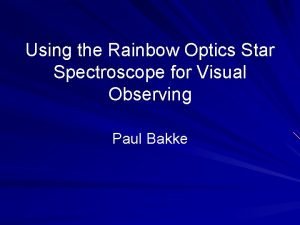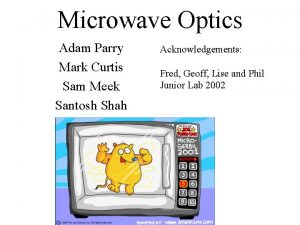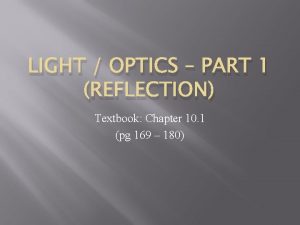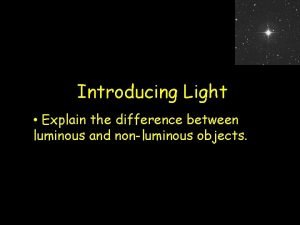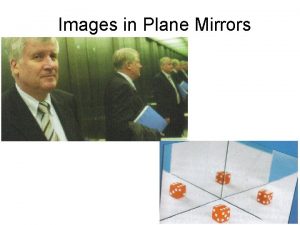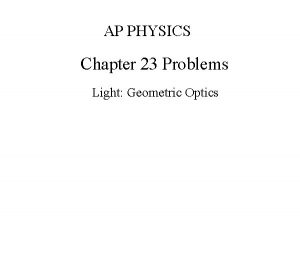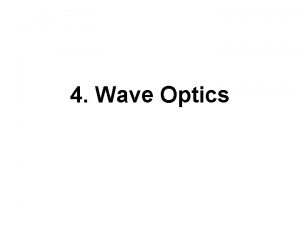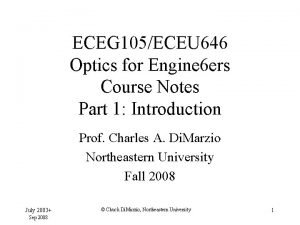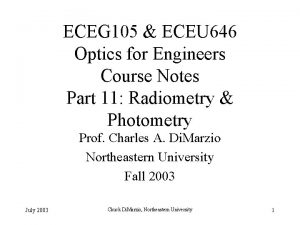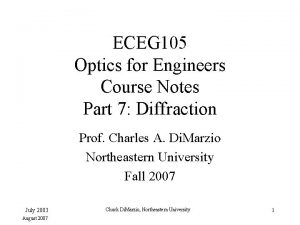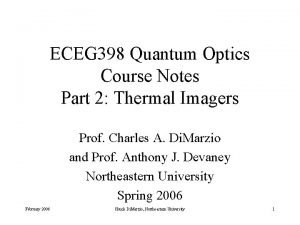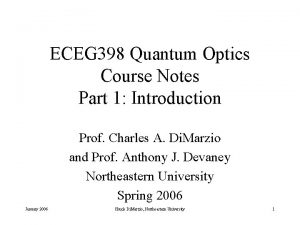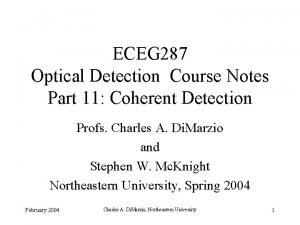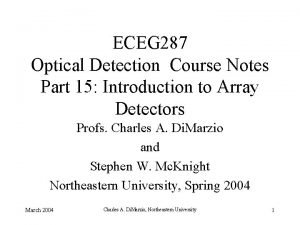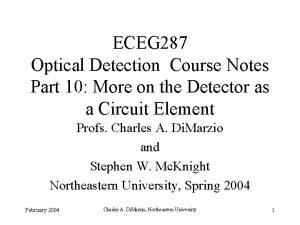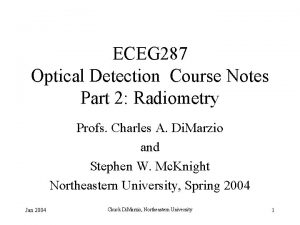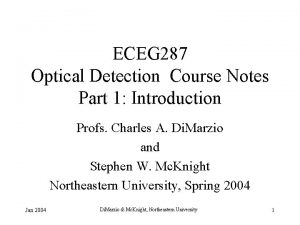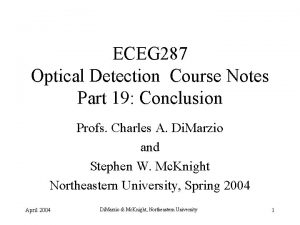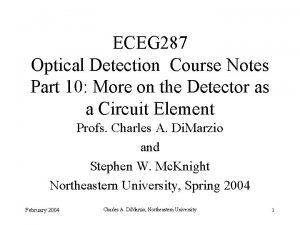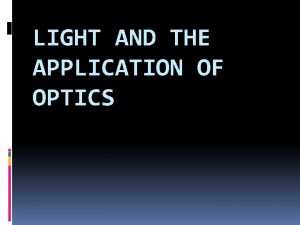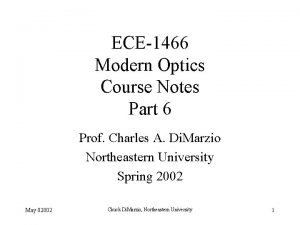ECEG 105ECEU 646 Optics for Engineers Course Notes


































- Slides: 34

ECEG 105/ECEU 646 Optics for Engineers Course Notes Part 3: Matrix Optics Prof. Charles A. Di. Marzio Northeastern University Fall 2008 July 2003+ Dec 2004 Aug 2007 Sept 2008 © Chuck Di. Marzio, Northeastern University 1

Matrix Optics Overview • Introduction • Derivation – Translation Matrix – Refraction Matrix • Cascading Matrices • The Thin Lens Again • The Thick Lens July 2003+ Dec 2004 Sept 2008 • Principal Planes – Equivalent Thin Lens – General Problems • Some Optical Failures • Some Examples – Simple Lenses • Some Lab Techniques © Chuck Di. Marzio, Northeastern University 2

ABCD Matrix Concepts • Ray Description – Position – Angle • Basic Operations – Translation – Refraction Ray Vector • Two-Dimensions – Extensible to Three July 2003+ Matrix Operation System Matrix © Chuck Di. Marzio, Northeastern University 3

Ray Definition x 1 July 2003+ © Chuck Di. Marzio, Northeastern University 4

Translation Matrix • Slope Constant • Height Changes x 2 x 1 July 2003+ Jan 2005 z © Chuck Di. Marzio, Northeastern University 5

Refraction Matrix (1) • Height Constant • Slope Changes ’ Ref. to Normal) July 2003+ Jan 2005 © Chuck Di. Marzio, Northeastern University 6

Refraction Matrix (2) Previous Result Recall Optical Power July 2003+ © Chuck Di. Marzio, Northeastern University 7

Cascading Matrices (1) Generic Matrix: Determinant (You can show that this is true for cascaded matrices) V 1 R 1 T 12 R 2 V’ 2 Light Travels Left to Right, but Build Matrix from Right to Left July 2003+ © Chuck Di. Marzio, Northeastern University 8

The Simple Lens (Matrix Way) Front Vertex, V Index = n Back Vertex, V’ Index = n. L Index = n’ z 12 July 2003+ © Chuck Di. Marzio, Northeastern University 9

Building The Simple Lens Matrix 2 Simple Lens Matrix July 2003+ © Chuck Di. Marzio, Northeastern University 10

The Thin Lens Again Simple Lens Matrix July 2003+ © Chuck Di. Marzio, Northeastern University 11

Thin Lens in Air Again July 2003+ Dec 2004 © Chuck Di. Marzio, Northeastern University 12

Thick Lens Compared to Thin July 2003+ Sept 2007 © Chuck Di. Marzio, Northeastern University 13

Example: 10 -cm FL Lens f = 10 cm. 100 Glass Lens Zn. Se Lens Ge Lens 80 60 40 R 2, cm. 20 0 -20 -40 -60 -80 -100 Relationship between R 1 and R 2 Depends on n. More on this later. July 2003+ Sept 2008 -100 -50 0 R 1, cm. 50 © Chuck Di. Marzio, Northeastern University 100 14

Object and Image Distances f = 10 cm. 50 40 30 s', Image Dist. , cm. 20 10 0 -10 -20 -30 -40 -50 July 2003+ -60 -40 -20 0 20 s, Object Dist. , cm. © Chuck Di. Marzio, Northeastern University 40 60 15

Thick 10 -cm Lens Focal Length Stays Nearly Constant as Thickness Increases July 2003+ © Chuck Di. Marzio, Northeastern University 16

The Thick Lens in Air Thick Lens Power is given by thin lens with correction Lensmaker’s Equation So we know f, but from what point do we measure? July 2003+ © Chuck Di. Marzio, Northeastern University 17

Principal Planes (1) Requirements on Principal Planes: *Conjugate: x 2 indep of : H H’ 1 *Unitary: s x 2 = x 1: s’ 1 July 2003+ Sept 2007 © Chuck Di. Marzio, Northeastern University 18

Principal Planes (2) Characterize in terms of Power Result Next Step: Use this information to locate the principal planes. Additional Condition July 2003+ HV © Chuck Di. Marzio, Northeastern University V’ H’ 19

Locating Principal Planes (1) H V h D V’ H’ h' D’ Starting With the Vertex Matrix h' h' h h hh' h' h July 2003+ Jan 2005 Sep 2008 © Chuck Di. Marzio, Northeastern University 20

Locating Principal Planes (2) h h' h' h' h h h' July 2003+ Jan 2005 Sep 2008 © Chuck Di. Marzio, Northeastern University 21 Stopped Here Tue 18 Jan 05

The Thick Lens (1) Spacing of Principal Planes h+h' Principal Planes h h' Focal Length Effective Thin Lens July 2003+ Sep 2008 © Chuck Di. Marzio, Northeastern University 22

The Thick Lens (2) In Air: h+h' h' h July 2003+ Sep 2008 © Chuck Di. Marzio, Northeastern University 23

Principal Plane Locations H H’ H to H’ is 1/3 of thickness P 1=P 2=0. 05/cm, n=1. 5 10 9 8 7 z 12, Thickness, cm. For a symmetric lens all these are nearly equal. V to H H to H’ H’ to V H, Front H’, Back PP PP 6 5 4 3 V, Front Vertex V’, Back Vertex True even for large thickness 2 1 0 -5 July 2003+ -4 -3 -2 -1 0 1 Locations: V, V', H, H' 2 © Chuck Di. Marzio, Northeastern University 3 4 5 24

Focal Length With “Bending” Little Change in Focal Length with Bending (Varying P 1 Keeping P 1+P 2 Constant, except for severe meniscus lenses July 2003+ symmetric © Chuck Di. Marzio, Northeastern University 25

Principal Planes with Bending HH’=VV’/3 holds, except for extreme meniscus lenses. P 1+P 2=0. 1/cm, z 12=0. 5 cm, n=1. 5 0. 4 H, H’ in lens from planoconvex to convex-plano. Mensicus lenses not common. p 1, Power of Front Surface, /cm. 0. 3 0. 2 0. 1 0 -0. 1 -0. 2 -0. 3 -0. 4 -2 July 2003+ -1 0 1 2 Locations: V, V', H, H' © Chuck Di. Marzio, Northeastern University 3 4 5 26

Bending an IR Lens (Ge: n=4) P 1+P 2=0. 1/cm, z 12=0. 5 cm, n=4 Meniscus lenses are more common in the IR because of the high indices of refraction, as we will see later. 0. 4 0. 3 p 1, Power of Front Surface, /cm. HH’=VV’X 3/4 for n=4, over a wide range of bending. 0. 2 0. 1 0 -0. 1 -0. 2 -0. 3 -0. 4 -0. 8 July 2003+ -0. 6 -0. 4 -0. 2 0. 4 Locations: V, V', H, H' © Chuck Di. Marzio, Northeastern University 0. 6 0. 8 1 27

Some Optical Failures f f’ Right Focal Length, Wrong Principal Planes For the Application July 2003+ Meniscus Lens for Infrared Detector © Chuck Di. Marzio, Northeastern University 28

Imaging Systems (1) B H f V D V’ H’ D’ s System Matrix July 2003+ B’ f’ s’ Imaging Matrix © Chuck Di. Marzio, Northeastern University 29

Imaging Systems (2) Conjugate Condition: July 2003+ © Chuck Di. Marzio, Northeastern University 30

Imaging Systems (3) Lens Equation Focal Length s w Lens Equation (in air) s’ w’ Magnification Angular Magnification (as before) July 2003+ © Chuck Di. Marzio, Northeastern University 31

Magnification Relationships Transverse Angular Determinant Condition Result: Invariant Quantity July 2003+ Lagrange Equation or Smith Helmholtz Equation © Chuck Di. Marzio, Northeastern University 32

Finding the Focal Points • Autocollimation – – Move Lens to Best Focus of Pinhole Image On Screen Measure Distance From Front Vertex to Focal Point Reverse Lens and Repeat for Back Focal Point. Does not give focal length! Need One Imaging Expt. July 2003+ © Chuck Di. Marzio, Northeastern University 33

Where Have We Been? • Matrix Formulation of Geometric Optics • Thick Lens Equation • “Bending the Lens” • Principal Planes (1/3 rule sometimes) • Using the Lens Equation – Focal Length – Vertex Distances vs. s and s’ July 2003+ Dec 2004 © Chuck Di. Marzio, Northeastern University 34 Stopped Thu 20 Jan 05
 Difference between ray optics and wave optics
Difference between ray optics and wave optics Reflection and refraction venn diagram
Reflection and refraction venn diagram Light and optics notes
Light and optics notes Form 646
Form 646 646 muhasebe kodu
646 muhasebe kodu Articolo 646 cp
Articolo 646 cp Dasd hac
Dasd hac Cs 646
Cs 646 +1 (646) 658-3695
+1 (646) 658-3695 646 15
646 15 Half brick wall in stretcher bond
Half brick wall in stretcher bond Course title and course number
Course title and course number Course interne course externe
Course interne course externe Facteur g
Facteur g Rainbow optics star spectroscope
Rainbow optics star spectroscope Gestaltism
Gestaltism Turba optics
Turba optics Optical power loss
Optical power loss Microwave optics
Microwave optics Single ray
Single ray Grade 10 optics review
Grade 10 optics review Purdue physics 241
Purdue physics 241 Difference between light source and luminous object
Difference between light source and luminous object Salt image characteristics
Salt image characteristics Hotwire fiber optics
Hotwire fiber optics Single slit envelope
Single slit envelope Optics topics
Optics topics Type of astigmatism
Type of astigmatism Geometric optics problems
Geometric optics problems Fourier optics
Fourier optics Vergence formula
Vergence formula The computational complexity of linear optics
The computational complexity of linear optics Snells law example
Snells law example Light optics bill nye
Light optics bill nye Introduction to fiber optics
Introduction to fiber optics














